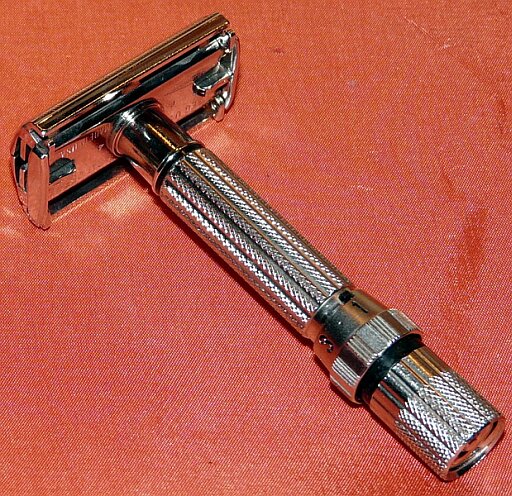October 6th, 2010 — Housekeeping, announcements etc

I have spent many years working in marketing in the video game industry. A very important aspect of this was getting reviews of our games in the media, so we sent out large numbers of free samples of every game to journalists hoping they would write about them. But the journalists never said in their reviews that they didn’t pay for the game. This is the same across every industry. You don’t think that an automotive magazine actually buys every Porsche and Ferrari that they test, do you?
In the video game industry in the early 1980s many kids started up their own magazines which were called fanzines, they did this just to get free games sent to them. And yes, we sent them free games. Nowadays people set up fansites and these days they don’t just get free games, they get invited to events, wined and dined etc etc. I know because I have been the marketing person who does this for them.
So fast forward to this blog, it is in men’s grooming which is a multi billion pound industry, so very soon after starting it I received offers of free stuff, which were turned down. This is because the stuff offered was not what I wanted to write about for my readers. If offers came in for stuff that was worth writing about then they would be very quickly accepted!
Which brings us nicely, to Frank Shaving. When I first discovered their brushes on eBay I took the risk with $9.99 of my own money and bought one. What came through the post was so fantastic that I thought that every wet shaver should know about it, so I evangelised these brushes with no gain whatsoever for myself. In fact the brushes are so good that I bought two more with my own money.
Then Ian Tang told me he was going to experiment with short lofted brushes and would I try them out for him. He sent me two and, in the interests of my readers, I wrote this up but stated quite clearly what had happened. Also when mentioning them on forums I made sure that the facts were very clear. Now $20ish worth of brushes does not buy very much of my time, so what was written was purely to inform the reader, not to benefit me. Anyone who thinks otherwise is plain stupid. It is worth pointing out that there are three articles on here about Simpson’s brushes and that I have paid for every Simpson’s brush that I own myself.
Also remember that most producers of kit send out samples all the time. In shaving I know of people who have sent stuff and people who have received stuff and then written about it as if they had bought it. But this is as nothing compared with forum owners who openly take money from vendors, presumably in exchange for favourable treatment and who then ban other, perfectly good traders. Is this for not paying up? And they then say that the bans are because these are bad traders, look at some of those who have been banned and decide for yourself.
Nanny’s Silly Soap Company is an excellent supplier of some of the best artisan soaps you can buy, iKon make one of the finest DE razors you can buy, New Forest Brushes sell very high quality brushes at reasonable prices, Connaught Shaving are one of the top suppliers of traditional shaving kit (especially blade sample packs) in Europe and Leisureguy is one of the most influential writers about traditional shaving. Yet you are not allowed to hear from them on certain shaving forums because they are banned, so the readers of those forums are misinformed because they are not getting the complete picture. In general some of the forums covering traditional shaving leave a lot to be desired.
So to get the record perfectly clear the only freebie I have ever received to write about in this blog was $20ish worth of short lofted Frank Shaving brushes from Ian Tang and it was made perfectly clear at the time that this was the case. Since then Leisureguy has very kindly offered to send me a copy of the 4th edition of the Leisureguy’s Guide to Gourmet Shaving, this after the article about it was published here. I have accepted because I want to read the book. Also Kimson has offered to send me a brush, once again after the article about them was published here. If he does I will tell my readers more about it, which is what they would want.
So I am on the moral high ground here and those who have criticised me are often doing so from a position of dubious morality. And to all those kit suppliers out there, keep on sending me the freebies, but no Fusion razors please.
October 5th, 2010 — Blades

Different brands of razor blades vary in many ways, but the three main things that we notice are sharpness, smoothness and longevity. There is a popular technique that is supposed to improve the smoothness of a blade and that is corking. The technique is very simple, you get the new blade and hold it firmly between your thumb and forefinger, then you cut lightly into a piece of cork and drag the length of the edge gently through. Some people use polystyrene instead of cork and some people repeat the action up to four times for each edge.
The proponents of this technique have a theory. They say that some blades (notable Feathers) can be initially rough but then become noticeably smoother with use. The theory goes that by gently sliding the edge through cork you remove microscopic imperfections so that when you actually get round to using it to shave with it will be much smoother. Obviously you wouldn’t do this to a naturally smooth blade, like an Iridium, which I mainly use, because there is no need.
Now the cynics say that all you are doing is wasting time and money. That corking will not improve the smoothness of a blade, but it will reduce the sharpness and the longevity. In fact some critics go so far as to say that corking removes the coatings of things like PTFE and so has a further effect on degrading the performance of the blade.
Now I must admit to being an agnostic in this debate, obviously both arguments have some credibility. If you have any experience of this then please let us know.
October 4th, 2010 — Shaving brushes

Horse hair shaving brushes are absolutely brilliant. I have this model and it is fantastic. I have seen it said that horse has 85% of the good attributes of badger hair and 85% of the good attributes of boar hair. They are also perfect for vegans and vegetarians because no animal is harmed in their manufacture, only clippings from normal grooming are used. Whichever way you look at it they are really excellent and are inexpensive. So why aren’t they more common?
The answer is that they used to be, but that anthrax ruined their reputation in the West. Below is a brief article from the May 1925 edition of the American Journal of Public Health, read this and you can see why they fell from grace. But don’t let this put you off, a good manufacturer in a first world country is going to make perfectly safe brushes, for instance Vie-Long in Spain make some excellent horse hair brushes.
Horse hair brushes today are very popular in Muslim countries that are in the developing world, badger hair is too expensive and boar hair is unclean. There does not seem to be a medical problem caused by the millions of men who use one of these brushes every day, so presumably public health techniques have advanced since the 1920s. And, of course this form of anthrax is very easily treated with common antibiotics these days.
ANTHRAX FROM SHAVING BRUSHES
THE DANGER from shaving brushes infected with anthrax spores has once more been painfully called to our attention by the sad death of Professor Ellermann of the University of Copenhagen. On December 17, 1924, a small spot appeared on his left cheek. It was soon followed by considerable edema, but without marked general symptoms. An examination of his shaving brush showed that it was dyed Chinese horsehair, made to imitate badger, and from the hair anthrax was isolated. The diagnosis was clear, and in spite of the injection of anthrax serum, Professor Ellermann died on December 24.
The experience of the American army is still fresh in the mind of everyone. During the war shaving brushes supplied by the Quartermaster’s Department of the army were found to be infected with anthrax spores. So many cases occurred both in the army and in civilian life that certain cities and states forbade the sale or handling of horsehair shaving brushes, especially those made in Japan. In the army there were 149 cases with 22 deaths, all of which were believed to be due to shaving brushes.
In England the first case of anthrax traced to a shaving brush occurred in 1915. From 1915 to 1921 in the civilian population 50 cases occurred with 18 deaths. Among the British troops in France between January, 1915, and February, 1917, 28 cases occurred, and in the navy six cases somewhat later than this. It was not possible to demonstrate that the infection in all of these cases came from shaving brushes, but since the majority of them were on some part of the face and neck, the indications were that shaving brushes could be fairly incriminated. So strong were the indications that the government prohibited the importation of shaving brushes manufactured in Japan. A large number of suspected shaving brushes were destroyed, and the infection was brought to an end. This new case, with the history of those which have already been published, indicates a source of danger against which we should constantly be on our guard.
And there is this from The Journal of The American Medical Association in 1921:
OCCURRENCE OF VIRULENT ANTHRAX BACILLI IN CHEAP SHAVING BRUSHES
DOUGLAS SYMMERS, M.D.; D. W. CADY, M.D.
In the six years elapsing between October, 1915, and November, 1921, thirty-six cases of cutaneous anthrax were admitted to the isolation pavilion of Bellevue Hospital and, of this number, ten, or approximately 28 per cent., followed the use of shaving brushes. During a period of one year and nine months ending Oct. 1, 1920, thirty-four cases of cutaneous anthrax were reported to the New York Department of Health and, of this number, seventeen, or 50 per cent., were traceable to shaving brushes.1 From these figures it appears not only that infested shaving brushes are to be incriminated as carriers of anthrax in an astonishing percentage of cases, but also that this method of conveyance is becoming increasingly common…………more
And to give some content from this side of the pond there is this from 1927:
“BACILLUS ANTHRACOIDES.”
A STUDY OF ITS BIOLOGICAL CHARACTERS AND RELATIONSHIPS
AND ITS PATHOGENIC PROPERTIES UNDER
EXPERIMENTAL CONDITIONS.
BY A. M. M. GRIERSON.
(From the Bacteriology Department, Edinburgh University.)
INTRODUCTION.
IT has long been recognised that within the group of Gram-positive aerobic sporing bacilli there occur saprophytic organisms which simulate the anthrax bacillus closely, both in their morphological and cultural characters, for example, in the specially characteristic appearance of surface colonies on culture medium. Organisms of this type have been described in bacteriological literature as “anthrax-like” bacilli, B. anthracis similis (McFarland, 1898), B. pseudo-anthracis (Burri, 1894; Hartleb and Stutzer, 1897), B. anthracoides (Hiippe and Wood, 1889; Bainbridge, 1903; Ponder, 1912; and others), and the biological relationship of such organisms to B. anthracis and other members of the group is of some interest and practical importance. In the routine examination of pathological and other material for B. anthracis, such organisms may be encountered and inoculation tests in animals may be considered necessary to ensure their differentiation from the anthrax bacillus. These organisms, however, have not been systematically studied and there is some
confusion in the literature regarding their various characters and relationships. Further reference will be made to this later.
The attention of the writer was first drawn to these organisms in the examination of shaving brushes from a consignment which had been reported to be contaminated with B. anthracis. These brushes were found to contain large numbers of organisms presenting the general morphological and cultural characters of the anthrax bacillus, their colonies, for example, being very similar, though the subsequent biological tests and inoculation experiments in animals differentiated them clearly from this organism. The inoculation tests proved that they were not devoid of pathogenic properties and at first raised the question as to whether they were attenuated forms of B. anthracis.
The pathogenicity of this type of organism under experimental conditions seemed therefore not only of considerable biological interest but also of practical importance in view of its apparent relationship to B. anthracis, and the initial observations thus led to a biological and experimental study of various strains from different sources and a further consideration of their relationship both to the anthrax bacillus and other members of the group of Gram-positive aerobic sporing bacilli………………………..more
It is, perhaps these anthrax problems that led to many shaving brushes to be labelled “sterilised” or in America “sterilized” . With modern medicine this is just an interesting footnote in history, it is just a pity that it has led to horse hair brushes being less common.
October 3rd, 2010 — Shaving soaps and creams

Shaving soaps and creams are made up of lots of different ingredients. In a natural, artisan soap, like Nanny’s Silly Soap Company make you can be sure that all these ingredients are good, but in something like an aerosol foam or gel you need to be a lot more careful. Obviously our governments ban the worst culprit chemicals, but our knowledge is expanding rapidly and what was OK five years ago might have severe question marks over it today.
We are lucky that manufacturers are required by law to tell us what they are putting in our shaving soaps and creams. Some of them put it in 1 point type to make life difficult for us, other use, say, dark green ink on a dark blue background. So sometimes you need a magnifier and a choice of lights to actually read what they are telling you. Once you have that information you can go to sites like Scorecard and Our Stolen Future to find the truth about what threats they pose. You can also look them up on Wikipedia and in the European Union’s REACH programme.
Here are some things you may want to avoid:
Triclosan. An anti bacterial and fungicide that is used as a preservative. It is suspected of causing skin or sense organ toxicity and immunotoxicity. It is restricted for use in cosmetics in Canada and Japan.It’s safety is currently under review by the FDA
Benzophenone. This is an Ultraviolet blocker used to protect colours and scents. It is suspected of causing endocrine-disrupting effects and causing skin or sense organ toxicity. According to the European Union’s REACH program it is a Substance of Very High Concern and should be replaced by safer alternatives.
Ethylenediamine. A solvent that is suspected of causing respiratory toxicity, immunotoxicity, neurotoxicity, skin or sense organ toxicity and asthma. It is banned for use in cosmetics in Canada.
FD&C Violet 1 (C39H40N3NaO6S2) This colouring has a very long chemical name. It is authoritatively recognized to cause cancer, according to the State of California.
Boric acid. An anti bacterial and anti fungal preservative. It is suspected of causing reproductive toxicity and has been banned for use in cosmetics in Japan and restricted in Canada and the European Union.
Benzyl alcohol. Yet another preservative it is authoritatively classified as known to be neurotoxic in man is suspected of causing immunotoxicity and skin or sense organ toxicity.
Coconut Diethanolamide. A detergent, wetting agent and emulsifier that is suspected of causing cancer, immunotoxicity and skin or sense organ toxicity.
Triethanolamine (TEA). A surfactant and emulsifier which is suspected of causing immunotoxicity, respiratory toxicity, skin or sense organ toxicity and asthma. TEA may cause an increased incidence of tumour growth in the liver in some female mice.
Parabens. Ethylparaben, Methyl Paraben, Butyl Paraben, Isobutylparaben etc. Very widely used preservatives. There is concern that chronic exposure to paraben compounds with estrogenic activity may contribute to breast cancer. Studies indicate that methylparaben applied on the skin may react with UVB leading to increased skin ageing and DNA damage.
Retinyl palmitate (also known as retinol palmitate). An anti-oxidant has been shown to accelerate cancer in lab animals.
Don’t get paranoid, there are plenty of other things that cause us harm in our lives. But it might be worth taking a bit more notice of what you are putting on your skin.
October 2nd, 2010 — Razors

The engineering drawings here are just fantastic. This is patent number 2,952,911 filed on March 19 1956 and issued on September 20 1960, a gap of four and a half years. The inventors are Meyer J Shnitzler and Michael Douglas Benedict Jr. As you can see the adjuster in the drawings went from 1 to 5 and in the production Fat Boy, Toggle, Slim etc it went from 1 to 9. Also the adjuster in the drawings is near the bottom of the handle just above the twist to open (TTO) knob whilst on production items it was moved to just under the head.
Gillette built a very small number of prototypes as per the patent drawing. These now are extremely valuable. There is one in the photograph above.
Another complication here is that Gillette actually had two different adjustment mechanisms. The one in the Toggle adjustable moved the guard bars. The one in the Fat Boy bent the blade to differing degrees. This patent says: “This results flows from the fact that the relative positions of the guard member is controlled by the adjusting knob”. So it looks like it isn’t the Fat Boy mechanism.





October 1st, 2010 — Razors

Many people who are into real, traditional shaving own several razors. This is understandable, razors are like cars with each make and model having its own personality and characteristics. In fact there are several that are considered “must haves”, especially some of the vintage Gillette models such as the Tech, the Fat Boy and the Super Speed. Some people amass large collections, which is not a bad idea when you consider just how fast some of them are going up in value.
Once you have started accumulating a few razors you have the problem of storing them. The upsurge in real shaving is so recent that there is little out there in the way of ready made solutions. The need is for something that allows the razor to dry out after use, that makes them easily accessible, protects them and keeps them organised. Here are a few ideas:
Razor stands. These tend to be designed to hold just one razor, usually as a set with just one brush. The makers of these obviously haven’t seen my bathroom. The acrylic stands from Cutting Edge Razors in America are just about the best that I have seen.
Toothbrush stands. Some of these are designed to be used by the whole family with room for 4 toothbrushes/razors, so they can be a good solution when you are starting your collection. They tend to be chromed metal or ceramic so have more Mohs of hardness than many razors, so they could be less kind to your razor than you may like.

Test tube stands. This is currently my favoured solution, you can store a lot of razors in a small space, they are cheap, the wood is kind to the razors and they keep things organised. You can get a wide range of different sizes to match your bathroom and your razor collection. Some people paint or varnish their test tube stands so they look nicer. The only weakness is that some very long handled razors can end up not hanging.
Pipe racks. People have been smoking and collecting pipes for centuries so there is a well established industry out there supplying storage solutions, many of which are perfect for storing DE razors. Some are highly decorative and some can be valuable antiques in their own right. Type “pipe rack” into eBay and you will be amazed with the vast variety on offer, some are plainly unsuitable but most are.
Spoon racks. It appears that collecting spoons is yet another manifestation of OCD and they have the storage solutions to go with it, many of which are just perfect for a razor collection. Once again eBay comes up with a large and varied selection, some new and some vintage and some with space for as many as 100 razors.
With all these possible solutions take care to make sure that your razors actually fit.

September 30th, 2010 — Books, videos and websites
September 29th, 2010 — General shaving chat

There are three points to this article. Firstly real, traditional shaving is not a walled garden like multibladed system shaving. The choices are infinite so you can tailor your shaving experience every day to be exactly what you want.
Secondly this is anti snobbery. Too many people in traditional shaving only want to talk about Simpson’s brushes, Feather All Stainless razors and Castle Forbes shaving cream, or similar expensive, high end kit. Yet there is stuff out there that costs a fraction of the price and is just as good, if not better.
Thirdly this article is about cheap shaving. How to have a great shave without spending a lot of money. Double edged safety razor shaving using a lather generated with a brush has been with us for over 100 years, there are no patents to prevent competition and there is lots of that competition from manufacturers in low cost developing countries. A recipe for bargains. We will be using kit from India, China and Egypt.
For this shave there will be no compromises. Everything will be of the very highest, most luxurious quality. You could shave with this combination for the rest of your life and be happy with it. The fact that it is so cheap is just an enormous bonus. So this is what we shall use:
Shaving soap. Palmolive tallow based shaving stick, less than 50 pence in British supermarkets. Say 1 penny per shave. This is one of the world’s great shaving soaps, it forms a smooth, lubricating, luxurious lather very easily and smells fantastic. In fact it is difficult to know what they could do better. This is raved about across the wet shaving community and is very highly sought after in America where it is not on general sale.
Brush. I could suggest a cheapo boar brush from the discount shop, but we are talking about luxury here. The Frank Shaving finest badger at $9.99 from China is our bargain, it is as good as big name brushes at ten times the price. A quality brush like this should last for decades so the cost is just a few cents per month. This is a really excellent brush that will easily and quickly face lather the shaving stick, then it will hold enough charge for several passes. It is luxuriantly soft yet has enough backbone to give your face a good massage.
Razor. The Lord L6 (in the L1822 packaging) would be an outstanding shaving razor if it was $30, but it is about a tenth of this in its native Egypt and can be picked up for just a few dollars/pounds in the West. This is a 3 piece Tech type razor so the blade is held very rigidly. The highly chromed head is an almost exact copy of the highly rated Merkur head and, if anything, shaves even better. This is a top razor even by absolute standards. The long handle is aluminium which gives it a nice balance and which just adds to the control you have over it. And as this has, effectively, an infinite life, the cost of using it is zero.
Blade. Super-Max in India are the second biggest manufacturer of razor blades in the world, making about 20% of all blades used and they are sold in 125 countries. 200 Super-Max Super Stainless double edged blades cost just £6. That is 3 pence per blade, which is less than 1p per shave. The blade snobs don’t like this blade and you can understand exactly why. However many more open minded shavers report good results.
So our total cost per shave is around 2 pence. This is a tiny fraction of the cost of using a multibladed system razor with a foam that comes out of an aerosol can. Not only is it cheaper, it is also better and it is far kinder to the environment.

I just shaved with this combination. The Palmolive stick, as ever, caught me out with just how good it is. Lush, lathers so easily and with that manly scent that is redolent of barber’s shops. The Frank Shaving brush was just perfect, face lathering quickly and well then holding enough for multiple passes. The razor is fantastic, light after a few weeks with the Mergress, but very wieldy with that long handle. And the blade was a little less smooth than my favoured Iridium to start with but quickly settled down to give an excellent shave. Two passes and a touch up gave the desired results with no nicks or weepers. All for 2 pence. How can anyone use an expensive multibladed system razor?
September 28th, 2010 — Books, videos and websites, Shaving brushes
September 27th, 2010 — Shaving brushes, Shaving soaps and creams

As I have stressed repeatedly everything about traditional shaving is personal to you. You do exactly what you want no matter what anyone else says. This is part of the whole anarchic joy and is the exact opposite of the constrained, walled garden, approach that the big global shaving companies try and force on their customers.
To make a lather to shave with we can use either soaps or creams (there are also soft soaps which are half way between) then using a bit of elbow grease, a good brush and some water we magically convert this into a superb, luxuriant cushion and lubricant for our shave. 1,000 times better than any aerosol foam or gel.
There are three techniques to build a lather. Firstly you can use a mug, bowl or scuttle, gradually adding the water and working till you have a rich lather. The second technique is the same but using the cupped palm of your left hand in which to build the lather. Thirdly you can actually build the lather on your face, just load the brush then work it on your face till it delivers the results you want. I go for this third option and here’s why:
- It is simpler, there is no intermediate step. It is also quicker.
- The action of building the lather with the brush is good for you. It massages and exfoliates your face.
- This process gives more time for the lather to soften your stubble which makes the whole shave better and easier.
- It keeps the lather warm.
- A good brush will hold enough lather for multiple passes, you don’t need to use a bowl.
- I shave in the shower, a bowl would tend to get unwanted water in it.
- Face lathering is much less complicated when you travel. One less item required.
- With shaving sticks it is awkward not to face lather.
- It gets the concentrated soap, at the beginning of the process, right into the stubble.
You may well completely disagree with all of this, which is your choice and which does not make either of us right or wrong. But face lathering works just perfectly for me.

















